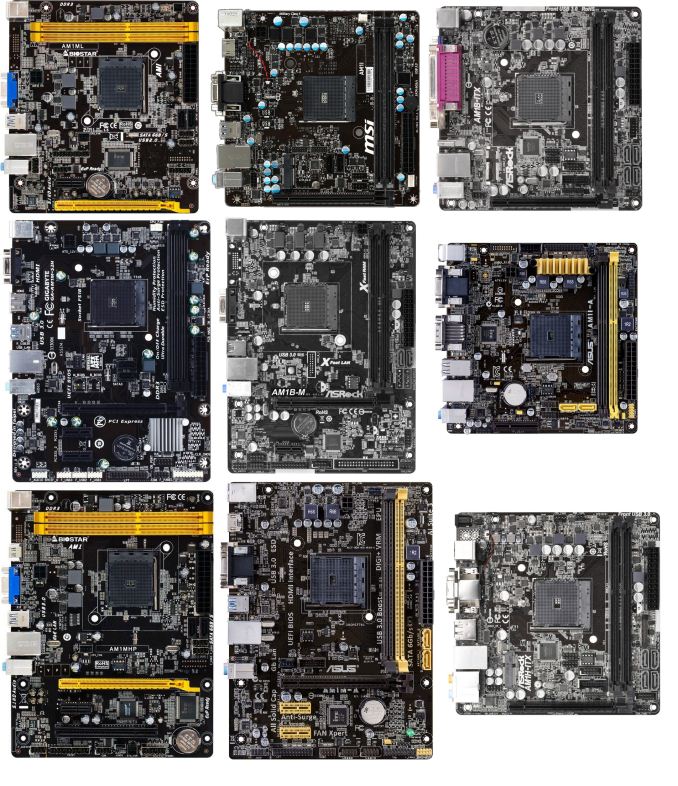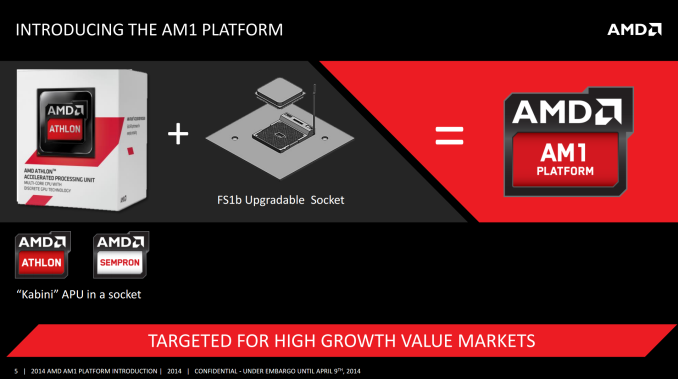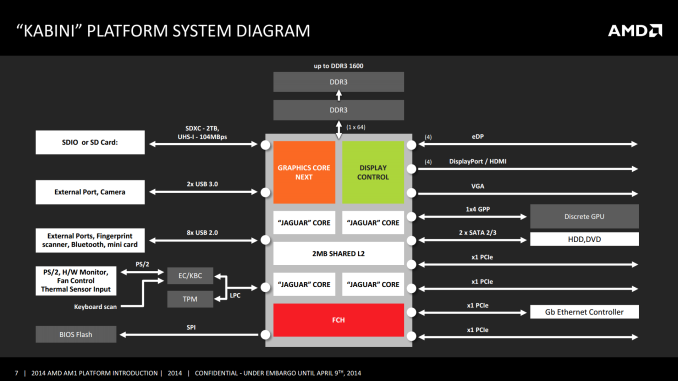The AM1 Kabini Motherboard Preview: Analyzing the Hardware
by Ian Cutress on April 19, 2014 2:00 PM EST
One of AMD’s primary feature points for the AM1 Kabini platform was the introduction of low-cost motherboards. The promotional material provided gave a suggested AM1 combined price of $60. Now after release the cheapest APUs are $31 for a dual core and $35 for a quad core. This should mean motherboards from $29 and up. Today we take a brief preview of nine motherboards currently on sale, which start at $33.
The AM1 Ecosystem
Almost every end-user I converse with prefers naming consistency in technology products. There has to be a clear progression in naming structure showing the development of a platform over time and generations. There have been plenty of examples – AMD’s enthusiast chipset (580/690/790/890/990FX), both AMD and NVIDIA’s GPU lines, Intel’s chipsets (P35, X48, P55, P67, Z77, Z87). The issue arises when the naming scheme is non-contiguous. The naming of AMD’s three main processor and chipset lines are as follows:
The top end features the AM3+ socket, which came from AM3, AM2+ and AM2. The mid-range is the FM2+ socket, deriving from FM2 and FM1. The low-price segment is now being called the ‘AM1 platform’. It makes it sound like it should be a very old version of AM3, because at least colloquially it will just be called AM1. In reality, that word ‘platform’ is the kicker here, because the socket is actually called FS1b:
What makes it called the AM1 platform is the use of a Kabini APU in an FS1b upgradable socket. That does not help that all the motherboards on sale will be given the AM1 designation. This means that if the next iteration of the Athlon processors using ‘Puma’ cores (codename “Beema”) comes along and they call it the ‘AM2 platform’ (insert more confusion with the AM2 socket), it might still be the FS1b socket in the middle of the motherboard.
Naming conventions aside, because Kabini processors are system-on-chips rather than platforms with a discrete south bridge, all the IO is determined on die. AMD is at least keeping the core of the IO the same across all the Kabini APUs:
The key points to note here are:
- Single Channel 64-bit DDR3/DDR3L
- Two USB 3.0
- Eight USB 2.0
- PS/2
- Trusted Platform Module Support
- Up to four eDP/DP/HDMI video outputs
- VGA output
- Four PCIe 2.0 lanes for a discrete GPU/PCIe device
- Two SATA 3 Gbps ports
- One PCIe 2.0 x1 lane allocated to an Ethernet controller
- Three PCIe 2.0 x1 lanes for other controllers (SATA, USB, LAN, WiFi, PCIe 2.0 x1 slots, PCIe to PCI bridges)
As we go through the following motherboards, we will see that some manufacturers use USB 3.0 or SATA 6 Gbps controllers, powered by the PCIe 2.0 x1 lanes, in order to bump up the functionality. There is scope for development in the networking and audio solutions as well.













64 Comments
View All Comments
tuxRoller - Sunday, April 20, 2014 - link
Nvidia's driver's provide performance that is pretty much identical to windows.AMD's is more variable.
From the benchmarks, there looks to be no point in going higher than an nvidia 750.
However, if you're gaming, and you want nice effects, you need that single thread performance.
Flunk - Sunday, April 20, 2014 - link
It's not like either has a very powerful GPU either. Xbox One is equivalent to a Radeon 7790 and PS4 a Radeon 7850. Plus, you don't have the CPU overhead from DirectX.Tranzz - Sunday, April 20, 2014 - link
http://semiaccurate.com/2014/04/16/adding-discrete...MonkeyPaw - Sunday, April 20, 2014 - link
Thanks. I wonder what resolution they were running. It does suggest that you can produce a mostly playable gaming setup for about $200 worth of core components. I wonder if AMD will ever scale Jaguar up even further? 8 cores and dual channel memory could be pretty potent for 50W or so. Might produce more excitement than the FX line.silverblue - Tuesday, April 22, 2014 - link
AMD obviously seems to think that a single, albeit fast, channel is enough to feed a small 'cat CPU. The trouble is, that may have been true for Brazos, but that had two cores and a weaker GPU. It'd be very interesting to see a dual channel Kabini - would it make a difference outside of GPU-based workloads?Mullins also needs a turbo mode, especially if Bay-Trail and its derivatives have one. Being able to ramp up clock speed for a short period of time so that the CPU can return to idle quicker and for longer is one of the reasons why Intel beats AMD for power consumption across the board (regardless of architecture and fab process).
FriendlyUser - Saturday, April 19, 2014 - link
You really can't beat the price. I am almost looking for an excuse to buy one...wolrah - Saturday, April 19, 2014 - link
"I never thought I would ever see a socketed motherboard in 2014 ship with a less-than-gigabit Ethernet port."I think we're at a point these days where anything new coming out with 100mbit ethernet or VGA as the primary display interface should be shunned as an outdated-out-of-the-box product.
VGA in particular, I mean who uses VGA? Even the luddites have mostly abandoned their cannonball CRTs, and a VGA-only LCD has always been the realm of idiocy.
harriharris - Sunday, April 20, 2014 - link
Not defending it myself here or anything... in fact I completely agree, but a lot of business still does. I know my workplace of over 50,000 personnel in a govt agency - every workstation I've sat at in 17 years there has had VGA connected monitors, even now with 16:10 LCDs in most places. They still run XP too... *sigh*xrror - Sunday, April 20, 2014 - link
Sadly another reason for VGA is if your building(s) with overhead projectors are wired with analog VGA. So for where I work that's maybe... 300 or so rooms rough guess.And while we've talked about changing to some sort of digital connection, fun things like HDMI copy projection, splitting to multiple projectors, etc pretty much skyrocket the already formidable costs.
So I dunno, we can't stay VGA forever (nor do we really want to) but we can't afford to switch. At all. No wonder the media services guy can't wait to retire - and I can't blame him.
tuxRoller - Saturday, April 19, 2014 - link
So, I can't get a board with displayport until we reach $50? Why? Isn't displayport royalty free?My issue is that I've a 1440p auria with both HDMI and do BUT, afaict, the HDMI interface doesn't support more than 1080p.
I really hate the HDMI spec. At least with displayport versions you know what to expect.